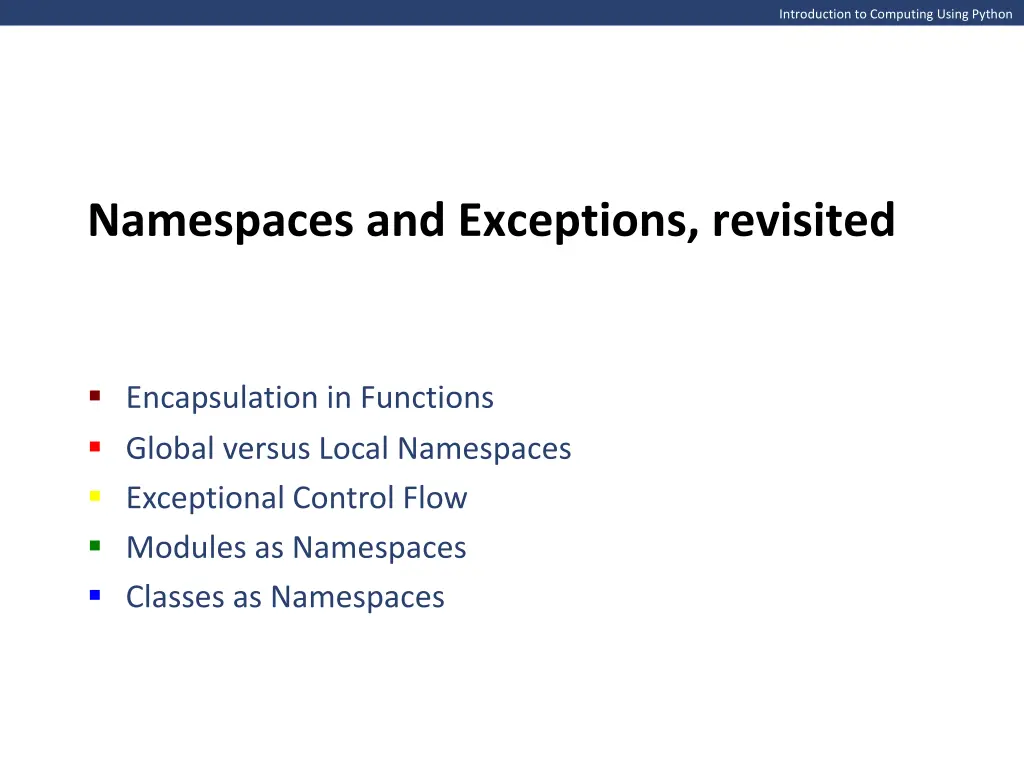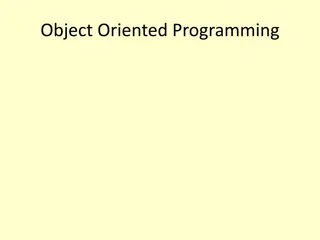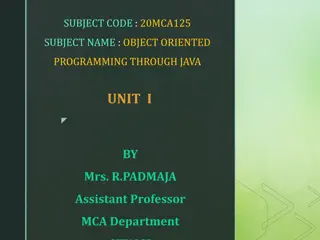
Understanding Encapsulation in Python Functions
Learn about the concept of encapsulation in Python functions, including how it promotes modularity, code reuse, and hides implementation details to make development easier. See examples of encapsulation through local variables and how it enables better organization and management of code in Python programs.
Download Presentation

Please find below an Image/Link to download the presentation.
The content on the website is provided AS IS for your information and personal use only. It may not be sold, licensed, or shared on other websites without obtaining consent from the author. If you encounter any issues during the download, it is possible that the publisher has removed the file from their server.
You are allowed to download the files provided on this website for personal or commercial use, subject to the condition that they are used lawfully. All files are the property of their respective owners.
The content on the website is provided AS IS for your information and personal use only. It may not be sold, licensed, or shared on other websites without obtaining consent from the author.
E N D
Presentation Transcript
Introduction to Computing Using Python Namespaces and Exceptions, revisited Encapsulation in Functions Global versus Local Namespaces Exceptional Control Flow Modules as Namespaces Classes as Namespaces
Introduction to Computing Using Python The purpose of functions Wrapping code into functions has several desirable goals: Wrapping code into functions has several desirable goals: Wrapping code into functions has several desirable goals: Wrapping code into functions has several desirable goals: Modularity: The complexity of developing a large program can be dealt with by breaking down the program into smaller, simpler, self-contained pieces. Each smaller piece (e.g., function) can be designed, implemented, tested, and debugged independently. tested, and debugged independently. tested, and debugged independently. Modularity: The complexity of developing a large program can be dealt with by breaking down the program into smaller, simpler, self-contained pieces. Each smaller piece (e.g., function) can be designed, implemented, pieces. Each smaller piece (e.g., function) can be designed, implemented, Modularity: The complexity of developing a large program can be dealt with by breaking down the program into smaller, simpler, self-contained Code reuse: A fragment of code that is used multiple times in a program or by multiple programs should be packaged in a function. The program ends up being shorter, with a single function call replacing a code fragment, and clearer, because the name of the function can be more descriptive of the action being performed by the code fragment. Debugging also becomes easier because a bug in the code fragment will need to be fixed only once. need to be fixed only once. Code reuse: A fragment of code that is used multiple times in a program or by multiple programs should be packaged in a function. The program ends up being shorter, with a single function call replacing a code fragment, and clearer, because the name of the function can be more descriptive of the action being performed by the code fragment. Debugging also becomes easier because a bug in the code fragment will Encapsulation: A function hides its implementation details from the user of the function; removing the implementation details from the developer s radar makes her job easier.
Introduction to Computing Using Python Encapsulation through local variables Encapsulation makes modularity and code reuse possible Before executing function double(), variables x and y do not exist >>> x Traceback (most recent call last): File "<pyshell#62>", line 1, in <module> x NameError: name 'x' is not defined >>> y Traceback (most recent call last): File "<pyshell#63>", line 1, in <module> y NameError: name 'y' is not defined >>> >>> res = double(5) x = 2, y = 5 >>> >>> x Traceback (most recent call last): File "<pyshell#66>", line 1, in <module> x NameError: name 'x' is not defined >>> y Traceback (most recent call last): File "<pyshell#67>", line 1, in <module> y NameError: name 'y' is not defined >>> x Traceback (most recent call last): File "<pyshell#62>", line 1, in <module> x NameError: name 'x' is not defined >>> y Traceback (most recent call last): File "<pyshell#63>", line 1, in <module> y NameError: name 'y' is not defined NameError: name 'y' is not defined >>> res = double(5) x = 2, y = 5 >>> x Traceback (most recent call last): File "<pyshell#62>", line 1, in <module> x NameError: name 'x' is not defined >>> y Traceback (most recent call last): File "<pyshell#63>", line 1, in <module> y def double(y): x=2 print('x = {}, y = {}'.format(x,y)) return x*y After executing function double(), variables x and y still do not exist x and y exist only during the execution of function call double(5); they are said to be local variables of function double()
Introduction to Computing Using Python Function call namespace >>> x, y = 20, 50 >>> >>> x Traceback (most recent call last): File "<pyshell#62>", line 1, in <module> x NameError: name 'x' is not defined >>> y Traceback (most recent call last): File "<pyshell#63>", line 1, in <module> y NameError: name 'y' is not defined >>> res = double(5) x = 2, y = 5 >>> x Traceback (most recent call last): File "<pyshell#66>", line 1, in <module> x NameError: name 'x' is not defined >>> y Traceback (most recent call last): File "<pyshell#67>", line 1, in <module> y NameError: name 'y' is not defined >>> x, y = 20, 50 >>> res = double(5) x = 2, y = 5 >>> x, y (20, 50) >>> >>> x, y = 20, 50 >>> res = double(5) Even during the execution of double(), local variables x and y are invisible outside of the function! def double(y): x=2 print('x = {}, y = {}'.format(x,y)) return x*y How is it possible that the values of x and y do not interfere with each other? Every function call has a namespace in which local variables are stored x y y x Function call double(5) shell 20 50 5 2
Introduction to Computing Using Python Function call namespace def h(n): print('Start h') print(1/n) print(n) Every function call has a namespace in which local variables are stored Note that there are several active values of n, one in each namespace; how are all the namespaces managed by Python? def g(n): print('Start g') h(n-1) print(n) n = 4 n = 4 print('Start f') print('Start f') g(n-1) g(n-1) n = 4 n = 4 print('Start f') def f(n): print('Start f') g(n-1) print(n) >>> f(4) >>> f(4) Start f >>> f(4) >>> f(4) Start f Start f Start g Start g Start h >>> f(4) >>> f(4) Start f Start f Start g Start g Start h Start h 0.5 0.5 2 2 3 3 4 >>> f(4) >>> f(4) Start f Start f Start g Start g Start h Start h 0.5 0.5 2 n = 3 n = 3 print('Start g') h(n-1) n = 3 n = 3 print('Start g') print('Start g') h(n-1) n = 2 n = 2 print('Start h') print(1/n) print(1/n) print(n) n = 2 print('Start h') print('Start h') n = 2 print(n) print(n) h(2) h(2) h(2) h(2) g(3) g(3) g(3) g(3) f(4) f(4) f(4) f(4) How does Python know which line to return to?
Introduction to Computing Using Python Program stack 1. def h(n): 2. 3. 4. 5. 6. def g(n): 7. 8. 9. 10. 11. def f(n): 12. 13. 14. The system dedicates a chunk of memory to the program stack; its job is to remember the values defined in a function call function call and The system dedicates a chunk of memory to the program stack; its job is to remember the values defined in a print('Start h') print(1/n) print(n) line = 9 the statement to be executed after g(n-1) returns n = 3 line = 14 print('Start g') h(n-1) print(n) n = 4 Program stack >>> f(4) >>> f(4) Start f >>> f(4) >>> f(4) Start f Start f Start g Start g Start h >>> f(4) >>> f(4) Start f Start f Start g Start g Start h Start h 0.5 0.5 2 >>> f(4) >>> f(4) Start f Start f Start g Start g Start h Start h 0.5 0.5 2 2 3 3 4 n = 4 n = 4 print('Start f') print('Start f') g(n-1) g(n-1) n = 4 n = 4 print('Start f') print('Start f') g(n-1) print(n) n = 3 n = 3 print('Start g') print('Start g') h(n-1) n = 3 n = 3 print('Start g') h(n-1) n = 2 print('Start h') print('Start h') n = 2 n = 2 n = 2 print('Start h') print(1/n) print(1/n) print(n) print(n) print(n) h(2) h(2) h(2) h(2) g(3) g(3) g(3) g(3) f(4) f(4) f(4) f(4)
Introduction to Computing Using Python Scope and global vs. local namespace Every function call has a namespace associated with it. This namespace is where names defined during the execution of the function (e.g., local variables) live. The scope of these names (i.e., the space where they live) is the namespace of the function. In fact, every name in a Python program has a scope Whether the name is of a variable, function, class, Outside of its scope, the name does not exist, and any reference to it will result in an error. Names assigned/defined in the interpreter shell or in a module and outside of any function are said to have global scope.
Introduction to Computing Using Python Scope and global vs. local namespace x >>> x = 5 >>> x 5 >>> shell module scope x = 5 scope.py 5 In fact, every name in a Python program has a scope Whether the name is of a variable, function, class, Outside of its scope, the name does not exist, and any reference to it will result in an error. Names assigned/defined in the interpreter shell or in a module and outside of any function are said to have global scope. Their scope is the namespace associated with the shell or the whole module. Variables with global scope are referred to as global variables. In fact, every name in a Python program has a scope Whether the name is of a variable, function, class, Outside of its scope, the name does not exist, and any reference to it will result in an error. Names assigned/defined in the interpreter shell or in a module and outside of any function are said to have global scope. Their scope is the namespace associated with the shell
Introduction to Computing Using Python Example: variable with local scope def f(b): # f has global scope, b has local scope def f(b): # f has global scope, b has local scope def f(b): # f has global scope, b has local scope def f(b): # f has global scope, b has local scope a = 6 # this a has scope local to function call f() return a*b # this a is the local a return a*b # this a is the local a return a*b # this a is the local a return a*b # this a is the local a return a*b # this a is the local a def f(b): # f has global scope, b has local scope a = 6 # this a has scope local to function call f() a = 6 # this a has scope local to function call f() a = 6 # this a has scope local to function call f() a = 6 # this a has scope local to function call f() a = 0 # this a has global scope a = 0 # this a has global scope a = 0 # this a has global scope a = 0 # this a has global scope print('f(3) = {}'.format(f(3))) print('f(3) = {}'.format(f(3))) print('f(3) = {}'.format(f(3))) print('f(3) = {}'.format(f(3))) a = 0 # this a has global scope print('f(3) = {}'.format(f(3))) print('a is {}'.format(a)) # global a is still 0 print('a is {}'.format(a)) # global a is still 0 print('a is {}'.format(a)) # global a is still 0 print('a is {}'.format(a)) # global a is still 0 print('a is {}'.format(a)) # global a is still 0 >>> === RESTART ==== >>> === RESTART ==== >>> >>> === RESTART ==== >>> >>> f(3) = 18 f(3) = 18 a is 0 >>> a b a Function call f(3) shell 0 3 6
Introduction to Computing Using Python Example: variable with global scope def f(b): # f has global scope, b has local scope return a*b # this a is the global a return a*b # this a is the global a return a*b # this a is the global a return a*b # this a is the global a return a*b # this a is the global a def f(b): # f has global scope, b has local scope def f(b): # f has global scope, b has local scope def f(b): # f has global scope, b has local scope def f(b): # f has global scope, b has local scope a = 0 # this a has global scope print('f(3) = {}'.format(f(3))) print('a is {}'.format(a)) # global a is still 0 print('a is {}'.format(a)) # global a is still 0 print('a is {}'.format(a)) # global a is still 0 print('a is {}'.format(a)) # global a is still 0 print('a is {}'.format(a)) # global a is still 0 a = 0 # this a has global scope print('f(3) = {}'.format(f(3))) print('f(3) = {}'.format(f(3))) print('f(3) = {}'.format(f(3))) print('f(3) = {}'.format(f(3))) a = 0 # this a has global scope a = 0 # this a has global scope a = 0 # this a has global scope >>> === RESTART ==== >>> >>> f(3) = 0 f(3) = 0 a is 0 >>> >>> === RESTART ==== >>> === RESTART ==== >>> a b Function call f(3) shell 0 3
Introduction to Computing Using Python How Python evaluates names def f(b): # f has global scope, b has local scope return a*b # this a is the global a a = 0 # this a has global scope print('f(3) = {}'.format(f(3))) print('a is {}'.format(a)) # global a is still 0 printf module builtins How does the Python interpreter decide whether to evaluate a name (of a variable, function, etc.) as a local or as a global name? f a printf() Whenever the Python interpreter needs to evaluate a name, it searches for the name definition in this order: 1. First the enclosing function call namespace 2. Then the global (module) namespace 3. Finally the namespace of module builtins global namespace 0 f() b Function call f(3) 3
Introduction to Computing Using Python Modifying a global variable inside a function def f(b): def f(b): def f(b): global a # all references to a in f() are to the global a global a # all references to a in f() are to the global a global a # all references to a in f() are to the global a def f(b): global a # all references to a in f() are to the global a a = 6 # global a is changed return a*b # this a is the global a return a*b # this a is the global a return a*b # this a is the global a return a*b # this a is the global a return a*b # this a is the global a def f(b): global a # all references to a in f() are to the global a a = 6 # global a is changed a = 6 # global a is changed a = 6 # global a is changed a = 6 # global a is changed a = 0 # this a has global scope print('f(3) = {}'.format(f(3))) print('a is {}'.format(a)) # global a has been changed to 6 print('a is {}'.format(a)) # global a has been changed to 6 print('a is {}'.format(a)) # global a has been changed to 6 print('a is {}'.format(a)) # global a has been changed to 6 print('a is {}'.format(a)) # global a has been changed to 6 a = 0 # this a has global scope print('f(3) = {}'.format(f(3))) print('f(3) = {}'.format(f(3))) print('f(3) = {}'.format(f(3))) print('f(3) = {}'.format(f(3))) a = 0 # this a has global scope a = 0 # this a has global scope a = 0 # this a has global scope >>> === RESTART ==== >>> === RESTART ==== >>> >>> === RESTART ==== >>> >>> f(3) = 18 f(3) = 18 a is 6 >>> a b Function call f(3) shell 0 3 6
Introduction to Computing Using Python Exceptions, revisited Recall that when the program execution gets into an erroneous state, an exception object is created This object has a type that is related to the type of error The object contains information about the error The default behavior is to print this information and interrupt the execution of the statement that caused the error The reason behind the term exception is that when an error occurs and an exception object is created, the normal execution flow of the program is interrupted and execution switches to the exceptional control flow
Introduction to Computing Using Python Exceptional control flow Normal control flow Exceptional control flow 1. def h(n): 2. 3. 4. 5. 6. def g(n): 7. 8. 9. 10. 11. def f(n): 12. 13. 14. print('Start h') print(1/n) print(n) The default behavior is to interrupt the execution of each active statement and print the error information contained in the exception object. print('Start g') h(n-1) print(n) >>> f(2) >>> f(2) Start f Start f Start g Start g Start h Start h Traceback (most recent call last): File "<pyshell#79>", line 1, in <module> f(2) File "/Users/me/ch7/stack.py", line 13, in f g(n-1) File "/Users/me/ch7/stack.py", line 8, in g h(n-1) File "/Users/me/ch7/stack.py", line 3, in h print(1/n) ZeroDivisionError: division by zero >>> >>> f(2) >>> f(2) Start f Start f Start g >>> f(2) n = 2 n = 2 print('Start f') n = 2 n = 2 print('Start f') print('Start f') g(n-1) g(n-1) print('Start f') g(n-1) print(n) n = 1 n = 1 print('Start g') h(n-1) n = 1 n = 1 print('Start g') print('Start g') h(n-1) n = 0 print('Start h') print('Start h') n = 0 n = 0 n = 0 print('Start h') print(1/n) print(1/n) print(n) print(n) print(n) h(0) h(0) h(0) h(0) g(1) g(1) g(1) g(1) f(2) f(2) f(2) f(2)
Introduction to Computing Using Python Catching and handling exceptions It is possible to override the default behavior (print error information and crash ) when an exception is raised, using try/except statements try: strAge = input('Enter your age: ') intAge = int(strAge) If an exception is raised while executing the try block, then the block of the associated except statement is executed strAge = input('Enter your age: ') intAge = int(strAge) print('You are {} years old.'.format(intAge)) print('You are {} years old.'.format(intAge)) except: print('Enter your age using digits 0-9!') The exceptcode block is the exception handler Default behavior: Custom behavior: >>> ========== RESTART ========== >>> Enter your age: fifteen Enter your age using digits 0-9! >>> >>> ======================== RESTART ======================== >>> Enter your age: fifteen Traceback (most recent call last): File "/Users/me/age1.py", line 2, in <module> intAge = int(strAge) ValueError: invalid literal for int() with base 10: 'fifteen' >>>
Introduction to Computing Using Python Format of a try/except statement pair The format of a try/exceptpair of statements is: The exception handler handles any exception raised in the tryblock try: <indented code block> except: <exception handler block> <non-indented statement> The exceptstatement is said to catch the (raised) exception It is possible to restrict the except statement to catch exceptions of a specific type only try: <indented code block> except <ExceptionType>: <exception handler block> <non-indented statement>
Introduction to Computing Using Python Format of a try/except statement pair def readAge(filename): 'converts first line of file filename to an integer and prints it' try: infile = open(filename) strAge = infile.readline() age = int(strAge) print('age is', age) except ValueError: print('Value cannot be converted to integer.') It is possible to restrict the except statement to catch exceptions of a specific type only >>> readAge('age.txt') Value cannot be converted to integer. >>> readAge('age.txt') Value cannot be converted to integer. >>> >>> readAge('age.text') Traceback (most recent call last): File "<pyshell#11>", line 1, in <module> readAge('age.text') File "/Users/me/ch7.py", line 12, in readAge infile = open(filename) IOError: [Errno 2] No such file or directory: 'age.text' >>> 1 fifteen age.txt default exception handler prints this
Introduction to Computing Using Python Multiple exception handlers def readAge(filename): 'converts first line of file filename to an integer and prints it' try: infile = open(filename) strAge = infile.readline() age = int(strAge) print('age is',age) except IOError: # executed only if an IOError exception is raised print('Input/Output error.') It is possible to restrict the except statement to catch exceptions of a specific type only except ValueError: # executed only if a ValueError exception is raised print('Value cannot be converted to integer.') except: # executed if an exception other than IOError or ValueError is raised print('Other error.')
Introduction to Computing Using Python Controlling the exceptional control flow 1. def h(n): 2. 3. 4. 5. 6. def g(n): 7. 8. 9. 10. 11. def f(n): 12. 13. 14. print('Start h') print(1/n) print(n) >>> try: f(2) except: print('!!') print('!!') print('!!') print('!!') print('!!') >>> try: f(2) except: except: except: except: >>> try: f(2) f(2) f(2) >>> try: >>> try: print('Start g') h(n-1) print(n) n = 2 n = 2 print('Start f') print('Start f') g(n-1) g(n-1) n = 2 n = 2 print('Start f') Start f Start f Start g Start f Start f Start g Start g Start h Start h !! print('Start f') g(n-1) print(n) n = 1 n = 1 print('Start g') print('Start g') h(n-1) n = 1 n = 1 print('Start g') h(n-1) n = 0 n = 0 print('Start h') print(1/n) print(1/n) print(n) n = 0 print('Start h') print('Start h') n = 0 print(n) print(n) h(0) h(0) h(0) h(0) g(1) g(1) g(1) g(1) f(2) f(2) f(2) f(2)
Introduction to Computing Using Python Modules, revisited A module is a file containing Python code. When the module is executed (imported), then the module is (also) a namespace. namespace. This namespace has a name, typically the name of the module. This namespace has a name, typically the name of the module. In this namespace live the names that are defined in the global scope of the module: the names of functions, values, and classes defined in the module. These names are the module s attributes. Built-in function dir() returns the names defined in a namespace When the module is executed (imported), then the module is (also) a When the module is executed (imported), then the module is (also) a namespace. namespace. This namespace has a name, typically the name of the module. In this namespace live the names that are defined in the global scope of the module: the names of functions, values, and classes defined in the module. When the module is executed (imported), then the module is (also) a >>> import math >>> >>> dir(math) ['__doc__', '__file__', '__name__', '__package__', 'acos', 'acosh', 'asin', 'asinh', 'atan', 'atan2', 'atanh', 'ceil', 'copysign', 'cos', 'cosh', 'degrees', 'e', 'erf', 'erfc', 'exp', 'expm1', 'fabs', 'factorial', 'floor', 'fmod', 'frexp', 'fsum', 'gamma', 'hypot', 'isfinite', 'isinf', 'isnan', 'ldexp', 'lgamma', 'log', 'log10', 'log1p', 'modf', 'pi', 'pow', 'radians', 'sin', 'sinh', 'sqrt', 'tan', 'tanh', 'trunc ] >>> >>> math.sqrt <built-in function sqrt> >>> math.pi 3.141592653589793 the name of the namespace must be specified >>> import math >>> import math >>> dir(math) ['__doc__', '__file__', '__name__', '__package__', 'acos', 'acosh', 'asin', 'asinh', 'atan', 'atan2', 'atanh', 'ceil', 'copysign', 'cos', 'cosh', 'degrees', 'e', 'erf', 'erfc', 'exp', 'expm1', 'fabs', 'factorial', 'floor', 'fmod', 'frexp', 'fsum', 'gamma', 'hypot', 'isfinite', 'isinf', 'isnan', 'ldexp', 'lgamma', 'log', 'log10', 'log1p', 'modf', 'pi', 'pow', 'radians', 'sin', 'sinh', 'sqrt', 'tan', 'tanh', 'trunc ] To access the imported module s attributes,
Introduction to Computing Using Python Importing a module When the Python interpreter executes an import statement, it: 1. Looks for the file corresponding to the module to be imported. 2. Runs the module s code to create the objects defined in the module. 3. Creates a namespace where the names of these objects will live. When the Python interpreter executes an import statement, it: 1. Looks for the file corresponding to the module to be imported. An import statement only lists a name, the name of the module without any directory information or .py suffix. Python uses the Python search path to locate the module. The search path is a list of directories where Python looks for modules. The variable name path defined in the Standard Library module sys refers to this list. current working directory Standard Library folders >>> import sys >>> sys.path ['/Users/me', '/Library/Frameworks/Python.framework/Versions/3.2/lib/python32.zip', . . . '/Library/Frameworks/Python.framework/Versions/3.2/lib/python3.2/site-packages'] >>>
Introduction to Computing Using Python The Python search path By just adding folder /Users/me to the search path, module example can be Suppose we want to import module example stored in folder /Users/me that is not in list sys.path imported names in the shell namespace; note that example is not in no folder in the Python search path contains module example 'an example module' def f(): 'function f' print('Executing f()') >>> ================ RESTART ================ >>> dir() ['__builtins__', '__doc__', '__name__', '__package__'] >>> >>> import example Traceback (most recent call last): File "<pyshell#79>", line 1, in <module> import example ImportError: No module named example ImportError: No module named example >>> import sys >>> sys.path.append('/Users/me') >>> import example >>> example.f <function f at 0x10278dc88> >>> example.x 0 >>> ================ RESTART ================ >>> dir() ['__builtins__', '__doc__', '__name__', '__package__'] >>> import example Traceback (most recent call last): File "<pyshell#79>", line 1, in <module> import example ImportError: No module named example >>> >>> import sys >>> sys.path.append('/Users/me') >>> import example >>> example.f <function f at 0x10278dc88> >>> example.x 0 >>> >>> dir() ['__builtins__', '__doc__', '__name__', '__package__', 'example', 'sys ] >>> ================ RESTART ================ >>> >>> dir() ['__builtins__', '__doc__', '__name__', '__package__'] '__package__'] >>> import example Traceback (most recent call last): File "<pyshell#79>", line 1, in <module> import example >>> ================ RESTART ================ >>> ================ RESTART ================ >>> dir() ['__builtins__', '__doc__', '__name__', def g(): 'function g' print('Executing g()') x = 0 # global var When called without an argument, function dir() returns the names in the top- level module the shell, in this case.
Introduction to Computing Using Python Top-level module A computer application is a program typically split across multiple modules. A computer application is a program typically split across multiple modules. One of the modules is special: It contains the main program . This module is referred to as the top-level module. The remaining modules are library modules that are imported by other modules and that contain functions and classes used by it modules and that contain functions and classes used by it One of the modules is special: It contains the main program . This module is referred to as the top-level module. The remaining modules are library modules that are imported by other When a module is imported, Python creates a few bookkeeping variables in the module namespace, including variable __name__: set to '__main__', if the module is being run as a top-level module print('My name is {}'.format(__name__)) name.py A module is a top-level module if: it is run from the shell it is run at the command line it is run at the command line it is run at the command line A module is a top-level module if: it is run from the shell it is run from the shell A module is a top-level module if: >>> === RESTART === >>> My name is __main__ >>> > python name.py My name is __main__
Introduction to Computing Using Python Top-level module A computer application is a program typically split across multiple modules. One of the modules is special: It contains the main program . This module is referred to as the top-level module. The remaining modules are library modules that are imported by the top-level module and that contain functions and classes used by it When a module is imported, Python creates a few bookkeeping variables in the module namespace, including variable __name__: set to '__main__', if the module is being run as a top-level module set to the module s name, if the file is being imported by another module print('My name is {}'.format(__name__)) name.txt >>> import name My name is name >>> My name is name >>> === RESTART === import name import.txt
Introduction to Computing Using Python Three ways to import module attributes 'an example module' def f(): 'function f' print('Executing f()') 1. Import the (name of the) module >>> >>> import example >>> >>> example.x 0 >>> example.f <function f at 0x10278dd98> >>> example.f() Executing f() >>> >>> import example def g(): 'function g' print('Executing g()') x = 0 # global var example.txt f g x example namespace __main__ module example 0 f() g()
Introduction to Computing Using Python Three ways to import module attributes 'an example module' def f(): 'function f' print('Executing f()') 2. Import specific module attributes >>> >>> from example import f >>> >>> f() Executing f() >>> x Traceback (most recent call last): File "<pyshell#28>", line 1, in <module> x NameError: name 'x' is not defined >>> >>> from example import f def g(): 'function g' print('Executing g()') x = 0 # global var example.txt f g x f namespace __main__ module example 0 f() g()
Introduction to Computing Using Python Three ways to import module attributes 'an example module' def f(): 'function f' print('Executing f()') 3. Import all module attributes >>> from example import * >>> >>> from example import * >>> >>> f() Executing f() >>> g() Executing g() >>> x 0 >>> def g(): 'function g' print('Executing g()') x = 0 # global var example.txt x f g x f g namespace __main__ module example 0 f() g()
Introduction to Computing Using Python A class is a namespace >>> list.pop <method 'pop' of 'list' objects> >>> list.sort <method 'sort' of 'list' objects> >>> list.pop <method 'pop' of 'list' objects> >>> list.sort <method 'sort' of 'list' objects> >>> >>> dir(list) ['__add__', '__class__', ... 'index', 'insert', 'pop', 'remove', 'reverse', 'sort'] A class is really a namespace A class is really a namespace The name of this namespace is the name of the class The names defined in this namespace are the class attributes (e.g., class methods) methods) The class attributes can be accessed using the standard namespace notation The name of this namespace is the name of the class The names defined in this namespace are the class attributes (e.g., class Function dir() can be used to list the class attributes __add__ x count pop . . . namespace list sort() __add__() count() pop()
Introduction to Computing Using Python >>> lst = [9, 1, 8, 2, 7, 3] >>> lst [9, 1, 8, 2, 7, 3] >>> lst.sort() >>> lst [1, 2, 3, 7, 8, 9] >>> >>> lst = [9, 1, 8, 2, 7, 3] >>> lst [9, 1, 8, 2, 7, 3] >>> list.sort(lst) >>> lst [1, 2, 3, 7, 8, 9] >>> >>> lst.append(6) >>> lst [1, 2, 3, 7, 8, 9, 6] >>> >>> list.append(lst, 5) >>> lst [1, 2, 3, 7, 8, 9, 6, 5] >>> lst = [9, 1, 8, 2, 7, 3] >>> lst [9, 1, 8, 2, 7, 3] >>> lst.sort() >>> lst = [9, 1, 8, 2, 7, 3] >>> lst [9, 1, 8, 2, 7, 3] >>> lst.sort() >>> lst >>> lst [1, 2, 3, 7, 8, 9] >>> lst = [9, 1, 8, 2, 7, 3] >>> lst [9, 1, 8, 2, 7, 3] >>> list.sort(lst) >>> lst >>> lst = [9, 1, 8, 2, 7, 3] >>> lst [9, 1, 8, 2, 7, 3] >>> lst.sort() >>> lst [1, 2, 3, 7, 8, 9] [1, 2, 3, 7, 8, 9] >>> lst = [9, 1, 8, 2, 7, 3] >>> lst [9, 1, 8, 2, 7, 3] >>> list.sort(lst) >>> lst [1, 2, 3, 7, 8, 9] [1, 2, 3, 7, 8, 9] >>> lst.append(6) >>> lst [1, 2, 3, 7, 8, 9, 6] Class methods A class method is really a function defined in the class namespace; when Python executes lst.sort() lst.append(6) instance.method(arg1, arg2, ) it first translates it to list.sort(lst) list.append(lst, 6) class.method(instance, arg1, arg2, ) and actually executes this last statement The function has an extra argument, which is the object invoking the method __add__ x count pop . . . namespace list sort() __add__() count() pop()
Introduction to Computing Using Python Exercise Rewrite the below Python statement so that instead of making the usual method invocations lst.sort() lst.append(6) instance.method(arg1, arg2, ) you use the notation list.sort(lst) list.append(lst, 6) class.method(instance, arg1, arg2, ) >>> s = 'hello' >>> s = 'ACM' >>> s.lower() 'acm' >>> s.find('C') 1 >>> s.replace('AC', 'IB') 'IBM' >>> s = 'ACM' >>> str.lower(s) 'acm' >>> str.find(s, 'C') 1 >>> str.replace(s, 'AC', 'IB') 'IBM' >>>






















